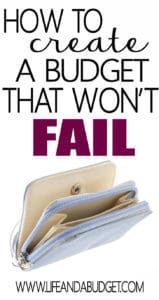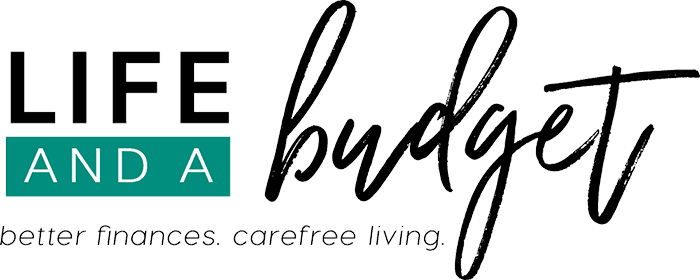Last week I went in on the 9 Reasons Your Budget Sucks. I hope you didn’t think I was going to leave you hanging. Today I want to share with you how you can get out of budget suck mode and create a budget that won’t fail.
It’s not hard once you get the hang of it and when you start meeting those financial goals, you’ll be happy you put in the effort. Without further adieu, let’s discuss the (my) criteria for creating a budget that won’t fail.

Be generous
When I say be generous, of course, it could mean include charitable contributions in your budget. But that’s not what I’m talking about. I’m specifically referring to you!
Be generous to yourself. Don’t be so restrictive with your budget that you can’t enjoy life. Be generous by including enough room for at least one thing that’s important to you. Without this aspect, you’re setting yourself up for failure.
Related Reading: How to Have a Life and a Budget
A great tool to learn how to successfully budget is the LAAB Budget Binder.
Get yourself some goals
Don’t create goals you can’t realistically achieve. Remember, we’re trying to create a budget that won’t fail. Focus on things you actually WANT to achieve and break them down into micro-goals. I like examples, so let me give you one.
Let’s say you’re 32-years-old like me and you want to be debt free (excluding your mortgage) by the time you’re 40-years-old. If you’re $80,000 in debt like me, don’t focus on the big number. Take a portion of your debt and focus on paying it off within a reasonable amount of time. Perhaps $10,000 in 6 months…something like that.
Be realistic with your expenses
If you have a baby and they go through a case of milk per week, don’t try to budget for only two cases per month. I can certainly attest to the fact that they won’t appreciate it very much! My son goes through the same amount of milk each month so I already know how much I’ll spend.
I don’t even try to save on this expense either because it’s one more thing for me to do (I hate over complicating things). I order enough milk through Amazon each month and the expense is the same. This helps me budget accordingly.
This same principle applies to you, dear friend. Don’t be unrealistic when budgeting unless you know for a fact you can save in a particular category. I don’t coupon, but many of you might so you may reasonably be able to say you’re going to spend $30 less on groceries this month.
I can’t say that, so I keep my grocery budget the same because I know how much food we’re going to eat. This is why it’s important to take your family into consideration when creating a budget. It allows you to set your expenses accordingly.
If you find yourself needing to cut expenses, you might want to check out some of these options to help you save more money.
- Use apps to help you save money on your groceries like Ibotta. Sign up for them using this link and you’ll receive $10 just for trying the app.
- Get free identity theft protection by using Credit Sesame. This is a free tool that gives you your credit score and monitors your identity.
- Stop buying bottled water and get you a plain ole water bottle and fill it up.
- Shop online using Ebates. If you’re new to Ebates, receive a $10 gift card to a retailer of your choice with your first $25 purchase. Sign up here!
- Use Etsy to make passive income.
- Save money on eating out by using Restaurants.com.
- If student loan refinancing is suitable for your situation, check out Credible and fill out their quick questionnaire and compare up to 12 different lenders.
- Sign up for Swagbucks and refer everyone! You even get Swagbucks for their Swagbucks (if that makes any sense). New users get a $5 sign-up bonus!
- Cut cable.
- Make sure you’re insured with the best insurance rates. Compare policies with Policy Genius to get the best term-life insurance your money can buy.
- Purchasing a gift card for someone? Purchase it using Cardpool and save up to 35 percent off the gift card amount!
Include your significant other and family
Your budget can’t be selfish. If you have other people in your life, realistically they can’t be excluded. Consider the needs of your spouse or significant other. If you’re not on the same page financially, make a great effort to at least get in the same chapter. Once you’ve done that, consider your family’s lifestyle and needs. This isn’t optional, so make it happen.
Plan for emergencies
If your budget doesn’t plan for emergencies, it’s destined to fail. If you account for all of your current expenses and forget to include car repair, a simple flat tire can throw your entire budgeting plan off. Include things like car maintenance and repairs in your budget, along with any auto insurance deductibles in case you have an accident.
Also, what if you lost your job or became ill and couldn’t work? Disability benefits (if you even have them) and severance (if your employer is so kind) will only take you so far. You need to have a fund designated for emergencies such as these. If you don’t, what’s the point in even having a budget?
Related Reading: 20+ Ways to Find Cash For Your Emergency Fund
Plan for unexpected/irregular expenses
Get ahead of life. Late fees, homeowners insurance, back to school, and unexpected travel due to family emergencies are not really unexpected. They are just a part of life.
All budgets need to include room for these types of events. It doesn’t matter how perfect your budget is, if you have no extra funds for travel due to a death in the family, you might resort to using debt to cover the expense.
That isn’t the goal. The goal is to stay out of debt and create budgets that cover life. For other expenses like insurance or back to school expenses, take an average of what you’ve spent within the last year.
Divide your irregular/unexpected expenses by the number of paychecks you receive in the year and set aside that amount each pay period.
Related Reading: How to Start Saving: A Guide For Beginners
Choose a budget that works for you
Let’s briefly go over a few different budgeting methods.
50/30/20 Budgeting
The principle of this budget is to split your costs into categories – necessities, savings/debt, and life. You take the amount of your take-home pay and split it up according to the following:
50 percent of your take-home pay is spent on your necessities. Necessities would be classified as housing, transportation, utilities, etc.
20 percent of your take home pay would go towards savings goals and/or debt repayment.
30 percent of your take home pay would be spent on life. These expenses include entertainment, shopping, dining, cable, internet, groceries and other variable expenses.
This budget is not the business for everyone. If you’re anything like me, I can tell you that you would feel restricted using this type of budget. This budgeting method is ideal for someone who enjoys classifying expenses and doesn’t mind managing your budget more often.
Need more information on 50/20/30 budgeting? Check these articles out:
- The 50/20/30 Budget – The Budget Mama
- The 50//20/30 Budget – Natalie Bacon
- Revisiting the 50/20/30 Budgeting Rule – MoneyNing
The Envelope System (Cash Budgeting)
This method of budgeting is good at helping someone with no impulse control. If you go to the grocery store to buy eggs and milk and come out with chicken, hot sauce, and B1G1 popcorn, this may be the type of system you need in your life.
The principle behind it is using cash only! To make it work, you set aside the cash needed for your some of your variable and fixed costs and put them in envelopes.
When you go to the grocery store, you would bring along the funds designated for groceries. If you’re going to pay the gardener, you would use the envelope with those funds.
The only drawback to this method is that you can’t pay for everything in cash. Things like mortgages and other expenses would be left in your checking account for safe-keeping. You would only withdraw funds where you can reasonably expect to pay cash.
I don’t like paying cash and many people find the envelope system involves too much work. Like I said previously if you’re having a hard time keeping your expenses in check, it could be worth a try.
Need more information on Cash/Envelope Budgeting? Check these articles out:
-
- Envelope Budgeting System: How it Works, Pros & Cons – Money Crashers
- The Envelope System Explained – Dave Ramsey
- A Comprehensive Guide to the Envelope System – Wisebread
Reverse Budgeting
This budgeting method is aggressive for many reasons. First, if you have big savings goals and lower obligations, you might choose to focus on your savings first and let everything else do what it do.
What I mean by this is you have a goal to save $12,000 in one year for a down-payment on your home. You decide you’re going to set aside $1,000 of your monthly take-home pay of $3,000. You take your savings off the top and force yourself to live on the remaining $2,000.
If you can do this, go on head with your bad self. I’m not hating, but it’s quite an aggressive approach — one I can’t expect to carry out successfully yet. A girl can dream, though.
Need more information on Reverse Budgeting? Check these articles out:
- The Reverse Budget Technique – Trees Full of Money (wouldn’t that be nice)
- Reverse Budgeting: Creating a Budget that Actually Works – Forbes
- Reverse Budgeting: Make it Work for You – Mindful Money
Zero-Based Budgeting
If you choose to use zero-based budgeting, you must account for every single dollar you spend. You are basically giving every dollar earned an assignment. You budget down to zero.
If you bring home $1,000 and pay all of your bills, account for all of your wants, and still have $100 left over, you have to give it an assignment.
The only thing I don’t like about this budget is that it’s not as flexible. When you have already appropriated all of your funds towards something specific and something unexpected pops up, you’d have to have money set aside for unexpected expenses or else you would have to readjust your entire budget.
If you find it hard to budget period, this one may be the first one you should try because it gives your money a plan. If you don’t have a plan for every dollar you earn, I guarantee you it will vanish into thin air.
This budgeting method also becomes very attractive if you have enough money to live off last month’s income. By using zero-based budgeting and living off last month’s income, you’re essentially on a journey towards defeating a paycheck to paycheck lifestyle.
Need more information on Zero-Based Budgeting? Check these articles out:
- How and Why to Use a Zero-Sum Budget – The Simple Dollar
- How to Make a Zero-Based Budget – Dave Ramsey
- The Power of a Zero-Sum Budget – Get Rich Slowly
Bi-Weekly Budgeting (Half-Payment Method)
This budgeting system involves setting aside half of all your bills each pay period. Since I’m paid bi-weekly, this is a loose version of the budget we use. We’ve adopted this method to suit our situation and it’s one I would encourage. We basically total all of our expenses and divide it by 2. My husband receives 2 paychecks a month and I usually receive 2 paychecks as well (some months I receive 3).
Half of our expenses are automatically deposited into our household account from our first paycheck. The same applies to the second paycheck. Our payment arrangements are in sync with our pay periods and we keep a buffer in our account so we don’t have to worry about whether we’ve been paid or not. This system is really effective for us and I’ve never in 7 years of marriage had to worry about multiple payments coming out of our account before payday.
Also note: I rarely spend that bonus paycheck on stuff we don’t need. I use this to continue building our buffer or contribute to emergency savings. Use that 3rd paycheck that comes twice a year wisely!
Need more information on Bi-Weekly Budgeting (Half-Payment Method)? Check out these articles:
- The Half-Payment Method – The Budget Mama
- Personal Finance Management on a Bi-Weekly Payment Schedule – The Simple Dollar
- Budgeting Bi-Weekly Pay – The Centsible Life
Put it on automation
Whatever budgeting system you decide to use, put it on automation. With modern technology, it’s easy to set up automatic payments and auto-deductions for your savings.
This eliminates the need to do everything yourself. It’s always a good idea to check for computer and human error if you have your bills and savings on automation, but you save time by not having to manually do it every pay period.
We currently have our savings automatically withdrawn from our household checking account at multiple intervals throughout the month. The majority of our bills are set up on automatic deduction, but I manually pay our mortgage, water, and power bill each month.
This arrangement isn’t ideal for variable expenses such as power or water because we sometimes have to transfer additional money into our household account to handle fluctuations.
Stick with it long enough to see results
Creating a budget that works for you involves some trial and error. However, it’s not wise to jump ship from one budget to another if you haven’t allowed enough time to determine if it actually failed.
One way to determine if you’ve got a budget that works for you is to allow enough time to achieve two short-term financial goals. If you haven’t gotten the results you want after around 90 days, change it up until you find the one that works best for you.
Wrapping Thangs Up
My goal for you is to leave here with enough information to be encouraged about setting up a budget that works for you. I know it’s easy to hate budgeting. Heck, I hate it. But it’s an essential component of your financial future. If your budget currently sucks, don’t be discouraged. Following the information presented will surely help you on your way to creating a budget that won’t fail.

